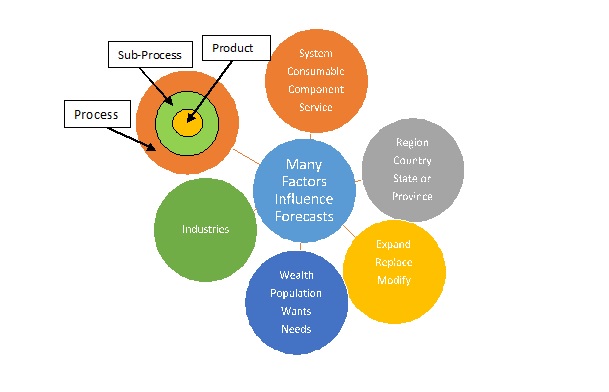NEWS RELEASE JANUARY 2016
Precision Forecasting of Flow Control and Treatment Products is Now Possible
The wealth of available information and the power of the computer now make possible bottoms-up precision forecasting of product and service revenue rather than the traditional top-down approach.
Because of rapid changes in key factors such as oil prices or political crises, it is now possible to economically provide precision forecasting on a continuously updated basis.
One example is the forecasting of compressors for flue gas desulfurization (FGD) gypsum formation. Precision forecasting requires a systematic analysis through each of eight steps.

The first task is to select the product category. In this case it could be all the blowers and compressors used for this service or just one of the options. The determination of the type of blower or compressor is a task unto itself. First one needs to determine the forecast for the product category.
The drivers include expansion of coal-fired power plants, replacement of existing compressors but also modification of power plants. Many countries have required retrofitting of FGD to boilers.
China is the largest purchaser of FGD gypsum blowers and compressors. The country can be divided into nine major combinations of provinces and autonomous zones to conform to the territory likely to be covered by an individual salesman.
Increased electricity consumption and the desire for clean air are the basic drivers behind the compressor purchases. So wealth, population, wants and needs are all relevant.
Secondary drivers are critical but are the most challenging. The FGD gypsum compressor is not used in all coal-fired power plants but only those with FGD systems. The sub process is critical. The dry approach requires no compressors. The wet approach with natural oxidation does not require compressors. The incorporating product is also important. One type of scrubber (tray tower) needs larger compressors than another type of scrubber (spray tower).
Precision forecasting requires that this comprehensive approach be used first for all the relevant processes, sub processes and incorporating products. When this data has already been determined, the effort to forecast compressors is greatly reduced.
Prediction metrics are critical. Failing all else one uses value/value metrics. A new coal-fired power plant of 1000 MW costs $2 billion. The compressors cost $1 million. So the forecast for coal-fired power revenues can be multiplied by .0000005. It is much better to use MW of capacity, gallons of slurry/MW and m3 of air required to obtain the prediction metrics.
The forecasts can be supplied with both revenue and unit numbers and even average size of units. This is possible because McIlvaine tracks every new project and existing power plant around the world and can determine average project size.
The associated revenue is subject to many variables, so establishing the amount of air required and number of units should be the base forecast. In a country such as China, the cost of a compressor purchased locally vs. internationally can be different. But one cannot use general assumptions. Investigation shows that Chinese purchasers have spent more money for the more reliable and efficient international compressors.
This choice is partly driven by the higher cost of electricity in China. Efficiency vs. price is also a factor in the type of compressor or blower selected. The forecasting is improved if the electricity costs in each country/state/province are also known and utilized.
Precision forecasting can be achieved by McIlvaine because it integrates all the products and services used in the $350 billion flow control and treatment market and because it uses the eight step bottoms-up approach.
For more information click on: Detailed Forecasting of Markets, Prospects and Projects



